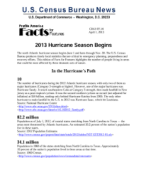Facts for Features: 2013 Hurricane Season Begins
The north Atlantic hurricane season begins June 1 and lasts through Nov. 30. The U.S. Census Bureau produces timely local statistics that are critical to emergency planning, preparedness and recovery efforts. This edition of Facts for Features highlights the number of people living in areas that could be most affected by these dramatic acts of nature.
In the Hurricane's Path
10
The number of hurricanes during the 2012 Atlantic hurricane season, with only two of them as major hurricanes (Category 3-strength or higher). However, one of the major hurricanes was Hurricane Sandy. It struck southeastern Cuba at Category 3 strength, then made landfall in New Jersey as a post-tropical cyclone. It was the second costliest cyclone on record (not adjusted for inflation) at $50 billion, ranking only behind Hurricane Katrina from 2005. The only other hurricane to make landfall in the U.S. in 2012 was Hurricane Isaac, which hit Louisiana.
Source: National Hurricane Center
<//www.nhc.noaa.gov/2012atlan.shtml>
<//www.nhc.noaa.gov/data/tcr/AL182012_Sandy.pdf> [PDF - 14.1 MB]
82.2 million
Population as of July 1, 2012, of coastal states stretching from North Carolina to Texas — the areas most threatened by Atlantic hurricanes. An estimated 26.2 percent of the nation's population live in these states.
Source: 2012 Population Estimates
<//www.census.gov/popest/data/state/totals/2012/tables/NST-EST2012-01.xls>
34.1 million
Population in 1960 of the states stretching from North Carolina to Texas. Approximately 19 percent of the nation's population lived in these areas at that time.
Source: 1960 Census <//www.census.gov/population/www/censusdata/cencounts>
240.9%
Percentage growth of the population of the states stretching from North Carolina to Texas between 1960 and 2012.
Source: 2012 Population Estimates and 1960 Census
<//www.census.gov/popest/data/state/totals/2012/tables/NST-EST2012-01.xls>
<//www.census.gov/population/www/censusdata/cencounts>
591,821
Collective land area in square miles of the states stretching from North Carolina to Texas.
Source: 2010 Census <//www.census.gov/geo/reference/state-area.html>
10 Year Anniversary of Hurricane Isabel
2003
The costliest and deadliest hurricane of 2003, Hurricane Isabel made landfall in the U.S. on the Outer Banks of North Carolina on Sept. 18, destroying many homes on the barrier island. Isabel later moved north through Virginia and Washington, D.C., and ended up causing about $3 billion in damage to the mid-Atlantic region.
Sources: National Hurricane Center
<//www.nhc.noaa.gov/2003isabel.shtml>
<//www.nhc.noaa.gov/outreach/history/>
Category 2
The strength of Hurricane Isabel at landfall based on the Saffir-Simpson scale, with maximum sustained winds measured at 105 mph. Isabel reached a peak as a Category 5 storm on Sept. 11 south of Bermuda, but gradually weakened as it approached landfall.
Source: National Oceanic and Atmospheric Administration <//www.prh.noaa.gov/cphc/pages/aboutsshs.php>
3
Counties that encompass the land area of the Outer Banks of North Carolina. The area includes parts of Currituck, Dare and Hyde counties.
Source: Census Quickfacts <//www.census.gov/quickfacts/dashboard/PST045215/37>
64,509
Population of Currituck County, Dare County and Hyde County in North Carolina in 2012.
Source: 2012 Census Population Estimates
<//factfinder2.census.gov/bkmk/table/1.0/en/PEP/2012/PEPANNRES/0400000US37.05000>
26,581
The number of occupied housing units in Currituck, Dare and Hyde counties combined.
Source: 2007-2011 American Community Survey Estimates
<//factfinder2.census.gov/bkmk/table/1.0/en/ACS/11_5YR/DP04/0500000US37053|0500000US37055|0500000US37095>
$236,500; 321,200; and 93,600
Median home value of owner-occupied units in Currituck, Dare and Hyde counties, respectively.
Source: 2007-2011 American Community Survey Estimates
<//factfinder2.census.gov/bkmk/table/1.0/en/ACS/11_5YR/DP04/0500000US37053|0500000US37055|0500000US37095>
32.0, 19.5 and 25.1 minutes
Mean commuting time to work for residents in Currituck, Dare and Hyde counties, respectively.
Source: 2007-2011 American Community Survey Estimates
<//factfinder2.census.gov/bkmk/table/1.0/en/ACS/11_5YR/DP03/0500000US37053|0500000US37055|0500000US37095>
7.8%, 11.1% and 25.1%
The percent of people who live below poverty level in in Currituck, Dare and Hyde counties, respectively.
Source: 2007-2011 American Community Survey Estimates
<//factfinder2.census.gov/bkmk/table/1.0/en/ACS/11_5YR/DP03/0500000US37053|0500000US37055|0500000US37095>
History of Hurricane Naming Conventions
Andrea
The name of the first Atlantic storm of 2013. Hurricane names rotate in a six-year cycle with the 2013 list being a repeat of the 2007 names.
Source: National Hurricane Center <//www.nhc.noaa.gov/aboutnames.shtml>
76
The number of hurricane names officially retired by the World Meteorological Organization. Although hurricane names are recycled every six years, for reasons of sensitivity, hurricane names that were so deadly and costly that re-use of the name would be considered inappropriate are retired.
Source: World Meteorological Organization <//www.wmo.int/pages/prog/www/tcp/Storm-naming.html>
1950
The year the Weather Bureau officially began naming hurricanes.
Source: Atlantic Oceanography and Meteorological Laboratory <//www.aoml.noaa.gov/hrd/tcfaq/J6.html>
2005
In one of the busiest Atlantic hurricane seasons on record, 28 named storms formed, forcing use of the alternate Greek alphabet scheme for the first time. When the National Hurricane Center's list of 21 approved names runs out for the year, hurricanes are named after Greek letters. Of the 28 named storms in 2005, 15 were hurricanes, with four storms reaching Category 5 status (Dennis, Katrina, Rita and Wilma) and three more being considered major.
Source: Atlantic Oceanography and Meteorological Laboratory <//www.aoml.noaa.gov/hrd/tcfaq/J6.html>
Preparing for Emergencies Using Census Bureau Statistics
The growth in population of coastal areas illustrates the importance of emergency planning and preparedness for areas that are more susceptible to inclement weather conditions. The U.S. Census Bureau's official decennial census and population estimates, along with annually updated socio-economic data from the American Community Survey, provide a detailed look at the nation's growing coastal population. Emergency planners and community leaders can better assess the needs of coastal populations using Census Bureau statistics.
The following is a list of observances typically covered by the Census Bureau’s Facts for Features series:
| Black (African American) History Month (February) Super Bowl Valentine's Day (Feb. 14) Women's History Month (March) Irish-American Heritage Month (March)/ St. Patrick's Day (March 17) Earth Day (April 22) Asian/Pacific American Heritage Month (May) Older Americans Month (May) Mother's Day Hurricane Season Begins (June 1) Father's Day |
The Fourth of July (July 4) Anniversary of Americans With Disabilities Act (July 26) Back to School (August) Labor Day Grandparents Day Hispanic Heritage Month (Sept. 15-Oct. 15) Unmarried and Single Americans Week Halloween (Oct. 31) American Indian/Alaska Native Heritage Month (November) Veterans Day (Nov. 11) Thanksgiving Day The Holiday Season (December) |
Editor’s note: The preceding data were collected from a variety of sources and may be subject to sampling variability and other sources of error. Facts for Features are customarily released about two months before an observance in order to accommodate magazine production timelines. Questions or comments should be directed to the Census Bureau’s Public Information Office: telephone: 301-763-3030; or e-mail: pio@census.gov.







